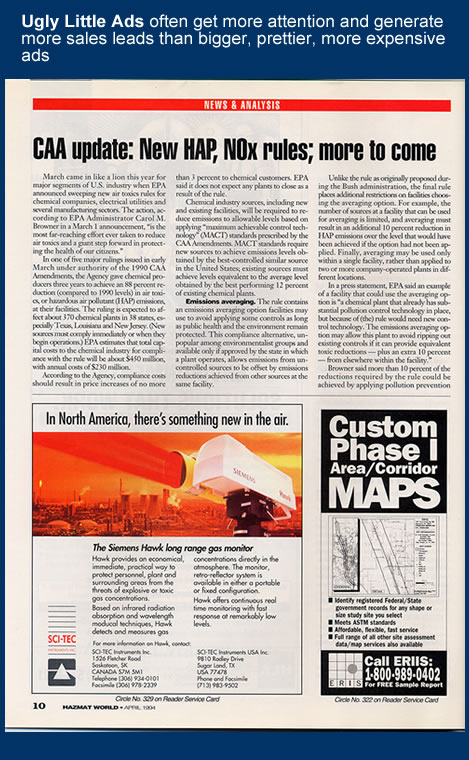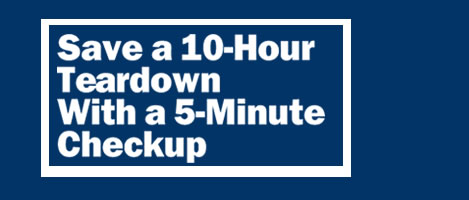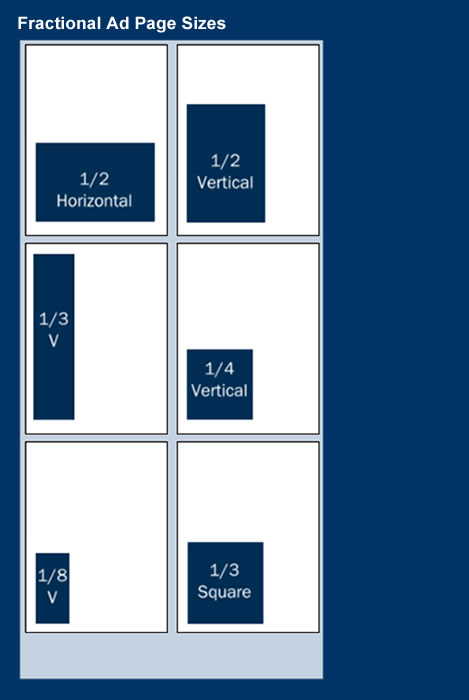


Tuesday Marketing Notes (Number 50 —September 12th , 2006)
A B2B Marketing Newsletter for BMA Members
____________________________________________________________
MAKE SURE YOU CONTINUE TO RECEIVE EACH ISSUE OF TUESDAY MARKETING NOTES—CLICK HERE TO RENEW YOUR FREE SUBSCRIPTION
(NOTE: if you’ve already signed up previously at this link above, no need to do so again)
INDEX TO PAST ISSUES OF TUESDAY MARKETING NOTES:
Click here
Special Savings Promotion for BMA Members—Click here
–––––––––––––––––––––––––––––––––––––––––––––––––––––––
B2B Print Advertising (Part 3: Ad Size: Which Size is Best for Your Advertising Program?)
by Eric Gagnon
Last week, we described the dangers of the “brand awareness” trap posed to most of us working in (and with) small to mid-sized companies in business-to-business markets, and described techniques for hard-wiring your ad layouts to generate what should be the most important end result of your print advertising, sales response—that’s sales leads and inquiries from interested prospects.
Once you’ve stopped chasing brand awareness, staying focused on generating sales response, it’s now time to address the notion that the best page size buys for print advertising programs are full-page ads. The truth is that full pages are often an unnecessarily risky expense for marketing programs in many small to mid-sized companies.
Yes, there are times when it’s better to buy full page ads. If you’re running marketing programs in a bigger company that can afford it, or if your company is launching a new product, and you can afford to spend the extra dollars without sacrificing your spending on better and more effective marketing methods, such as direct mail and trade shows, then, by all means make full page ads part of your program.
However, like most of us out here in the real world of B2B marketing, if you’re running a marketing program for a small or mid-sized company, don’t bend to the conventional wisdom that you’re always better off running full page ads instead of fractional-page ads.
If they’re designed for clear, effective presentation, fractional size ads can often pull as well or better than full pages. If you have a good product, and you present clear and compelling benefits for it, and you motivate your reader to contact you for more information, then, by using techniques of clear presentation, there isn’t any reason you can’t produce a fractional ad that grabs as much or more attention as the full page ads surrounding it.

How do you know when to run half, quarter, or smaller page sizes instead of full pages? I like to work this based strictly on my (and my client’s) gut level instincts: Considering the risk of failure and the availability of other, better, marketing options, if we both believe that full pages are too expensive, then we go with fractionals and save the difference, or apply it to other, more effective marketing methods.
Put another way, whenever it hurts too much to run a full page ad, that’s when you need to drop down to a smaller page size.
Never Run a Full Page Ad When a Smaller Size Will Do
Many seasoned B2B marketers already know you don’t have to run full page ads to generate solid sales response. Just flip through the pages of a couple of years’ worth of issues in your industry’s top trade publication. Notice that while many of the slick, colorful full-page ads appear and then mostly disappear by every third or fourth issue, some of the smaller, fractional-page ads continue to repeat, month to month, year after year.
These successful fractional ads are the lead- and sales-generating workhorses for the companies they serve, generating solid returns every time they appear. They keep working every time, while most of their more colorful, full-page neighbors fade away after a few issues.
Key Elements of Effective Fractional Print Ads
Here are some key characteristics for producing effective fractional-page ads, along with some examples of these elements. . .
Bold Headlines
In fractional ads, headlines are even more important—the shorter, and the bolder, the better. You can amplify the boldness of your headline by reversing it in white type inside a solid color box, as in the example below:

If you have space, a subhead tucked below the headline is often enough to stop your reader and get their attention on the page. A headline and subhead combined can communicate the gist of your product’s major benefit to your reader, all by themselves:

Short, Fast-Reading Body Copy
Obviously, long copy won’t fit in a fractional ad’s short copy space. So, write a brief statement of your product’s major benefit, using a benefit that’s important to your reader. Also, if possible, add some bullet points summarizing other key benefits and features to fill your busy skim-readers in on the essential benefits of your company’s product.
A Clear, Compelling Offer
Build your fractional ad around a compelling offer to get your reader to take one step closer to buying your product. For fractional ads, your offer is as important as the headline, and more important than your ad’s body copy.
This offer can be a discounted price, a free sample, or better yet, an informational premium, such as a report, white paper, book, or any other item that helps your readers to be more productive, profitable, or efficient in their jobs or businesses—while showing how your product helps them achieve these benefits.
Offers for information-based premiums used in fractional ads are also very effective tools for driving readers to your company’s Web site, where they can receive your premium online, after supplying a mimimal amount of contact information (preferably, only a first name/lastname, and an e-mail address).
Last but not least, make it clear to your reader what they need to do next to contact your company to take you up on your offer. Be clear and assertive: Interested, busy readers want to know what they need to do next—now.

Best Fractional Ad Sizes
Which ad size is right for your company? To determine which ad size works best for presenting your product, and which size offers the best combination of sales response compared to cost, you can test and track one fractional size, and then the next half-size below it. For example, if running a half-page ad one month, try scaling this ad down to a quarter-page size and test it the next month—you might pull almost the same response for up to 40% less cost.
Many smaller companies can’t afford full pages to begin with, and that’s just fine, too. Go with the largest fractional size you (or your client) can afford to buy on a sustained basis (for at least three insertions), and do your best to make it work.
Here’s a rundown of the most common fractional ad sizes available, and the approximate page sizes for each, in both magazine format and larger tabloid-format publications.

For Magazine-Format (8” W X 10” H) Publications:
• Half-page horizontal (6-7/8” W X 4-7/8” H): For magazine-format publications, the half-page horizontal ad size is a very workable size for presenting all the elements of your company’s advertising: headline, body copy, subheads, and call-to-action;
• Half-page vertical (4-5/8” W X 7-1/2” H): For layout purposes, the half-page vertical ad size is an even better size than the half-page horizontal size. Unfortunately, it’s not as available in many publications—but it’s a very good format and you should use it when you can;
• One-third vertical (2-1/4” W X 10” H): One-third vertical size ads cost approximately 25% less than half-page sizes. Because they run top to bottom on the printed page, one-third verticals tend to dominate pages where they appear, almost as well as larger page sizes. While its narrow width poses a challenge for fitting headlines and graphic elements, a good ad layout designer can usually overcome this problem;
• Quarter-page vertical size (3-3/38” W X 4-7/8” H): Quarter-page ad sizes are perhaps the most efficient fractional ad size, in terms of usable space and cost, since they’re generally 40% less expensive than half-page ad sizes, and their near-square aspect ratio makes a very efficient space for your ad layouts. This square format makes quarter-pages a better size for layout purposes than one-third verticals, which means your headlines and copy will often read better in this format;• One-eighth page (2-1/4” W X 5” H): Usually the smallest available display ad size found in magazine-format publications, the 1/8 page ad size is the least workable ad size for most trade marketing applications. However, if your company offers a relatively well known, or easily-understood product or service in your industry—such as an information service or commodity product, this ad size can be used very much like a Rolodex card to communicate your company’s Web address or toll-free order number, so readers can find you when they need your product or service.
For Tabloid-Size (10-1/2” W X 14-3/8” H) Publications:
Junior tabloid (7-3/8" W X 9" H) and Quarter-page
(4-3/8” W X 3-1/2” H): For tabloid-size publications, the junior tabloid page size or the smaller quarter-page are very versatile fractional ad space sizes. In larger tabloid publications, sizes smaller than junior tabloids or quarter-pages tend to become buried next to other ads, since the larger tabloid size can accommodate more ads on a single page. Because of this, the quarter-page ad size is the smallest ad size your company should run in a tabloid-sized publication.
Next week, we’ll discuss best ways to select trade media publication buys for your B2B print advertising programs . . .
Comments? Questions? Send them to me at: eric@realmarkets.net
_____________________________________________________________
Attention Marketing Managers:
Get a Second Opinion on Your Marketing Program. . . FREE
Think you should be spending less and getting more from your current marketing program? Tired of hearing empty “branding” promises from your ad agency that never seem to translate to actual, measurable sales results?
Or, have you been losing out on important new selling opportunities due to poor execution in your marketing projects?
Let us give you a second opinion on your current B2B marketing program and deliverables, at no cost or further obligation.
For more information, contact us at: ericgagnon@verizon.net or click on this link below:
_____________________________________________________________
Eric Gagnon (eric@realmarkets.net), is president of GAA (www.realmarkets.net), a sales and business development consulting firm, and is the author of The Marketing Manager’s Handbook, the master study guide for the Business Marketing Association’s Marketing Skills Assessment, Skill Builder, and Certification (MSA/B/C) programs.
For more information on The Marketing Manager’s Handbook, available to BMA members at a special discount, link to:
http://www.businessmarketinginstitute.com/book.html
_____________________________________________________________
Test, Train, and Build Your B2B Marketing Skills for Better Sales Success: BMA Announces New Assessment, Training, and Certification for B2B Marketing Managers
For more information on the new BMA Marketing Skills Assessment, Skill Building and Certification (MSA/B/C) training and professional development program, visit http://www.businessmarketinginstitute.com







